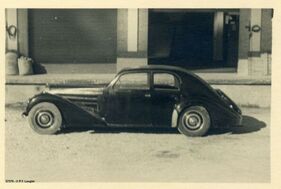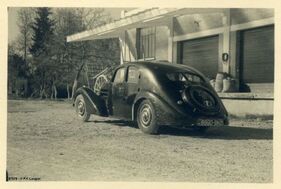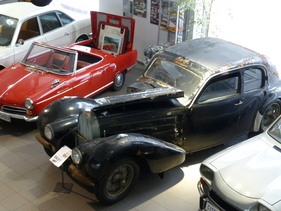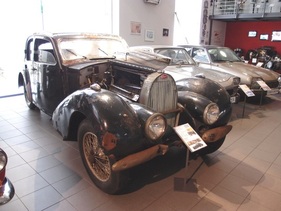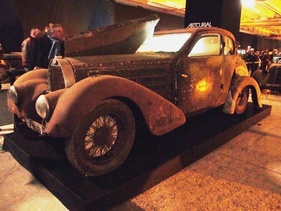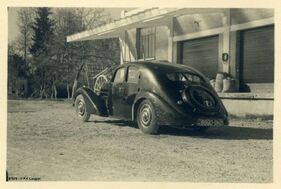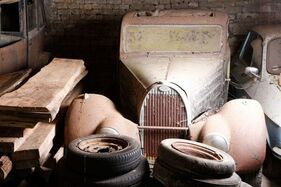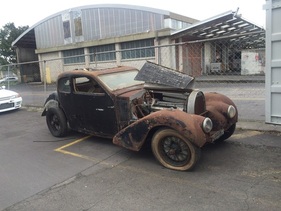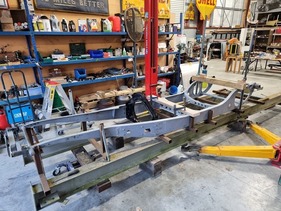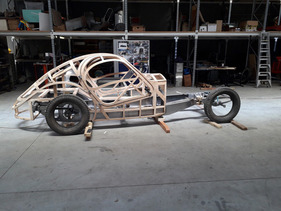It has now been nine years since the famous "Baillon collection" hit the press. This "barn find of the century" contained top-class automobiles, although most of them were more likely to be associated with the term "precious scrap". Anyone who was lucky enough to experience the exhibits shown as part of the Artcurial auction at the Rétromobile 2015 will certainly remember this. This was undoubtedly due to the presentation of the objects, the atmosphere of which can be aptly described as "eerily beautiful". However, in the dim light, visitors could also be seen at the time meticulously examining the exhibits in detail - presumably because they already had very specific ideas about their future use.
At the auction in February 2015, all 59 lots were sold at top prices. You may remember the Ferrari 250 GT SWB California Spider from 1961 from a prominent previous owner, which found a new owner for the hammer price of 14.2 million euros. Or the rather desolate Talbot Lago T 26 Coupé by Saoutchik, brutally shortened in an accident and worth a handsome 1,450,000 euros to one bidder, comes to mind. Many a reader will have wondered what has become of the "Baillon cars" since then...
Series and special bodies
In the following, we will talk about one car from this collection, namely the Bugatti Type 57 Ventoux from 1937 with chassis number 57579, which was offered as lot 40 at the time. Its history is somewhat adventurous. It will take us across several countries and ultimately even to the other side of the globe. But first a little general information about the Bugatti T 57 Ventoux.

The vehicles of the 57 series were created between 1934 and 1940 under the responsibility of the highly talented Jean Bugatti, who died in an accident during a test drive in 1939. The "Ventoux" model was a four-seater coupé with two doors, one of the four basic body designs available ex works. In addition to the "Ventoux", there were also the "Stelvio" (convertible, 4 seats, 2 doors), "Atalante" (coupé, 2 seats, 2 doors) and "Galibier" (saloon, 4 seats, 4 doors) versions. The bodies for the Type 57 were mainly produced by Bugatti in Molsheim, but often also by the coachbuilder Gangloff in Colmar. In addition, as was customary at the time, there were more than 20 other coachbuilders who fitted the chassis of the T 57 with special bodies. In October 1936, a Ventoux could be ordered from the Bugatti factory for 82,000 francs. One year later, 103,500 francs were already due.
According to in-depth research by Belgian Bugatti expert Pierre Yves Laugier, our protagonist with chassis number 57579 and engine no. 417 left the factory in September 1937 as a "rolling chassis" and was then "dressed" by Gangloff. Not as a "Ventoux" coupé, however, but as a four-door streamlined saloon. This body resembled the four-door "Galibier" body, but was also somewhat similar to the Type 57 Berline no. 57728 from the former "Schlumpf Reserve Collection", which was also manufactured by Gangloff and is now housed in the Autovision Museum, having been restored in the meantime. However, the interesting history of this equally well-traveled vehicle will not be discussed in detail here.
From France to Australia
In any case, according to Laugier, the limousine (or Berline, as it was known in the local language) with a Gangloff body, no. 57579, ended up at a dealer in Troyes, who sold it to a Mr. Jean Lanez. The latter was a member of the Résistance during the war, was arrested and died in 1945 as a result of severe mistreatment in the Flossenbürg concentration camp. After several changes of ownership in the post-war period, the car finally ended up with the aforementioned Roger Baillon in 1964.
However, No. 57579 had in the meantime been fitted with a "Ventoux" body - presumably at the car lot of Henri Novo, then known as the "Bugatti cemetery" and now run by the third generation as "Garage Novo". This probably came from a Bugatti with chassis number 57659, which was also stored there. Unfortunately, nothing is known about the whereabouts of Gangloff's original streamlined limousine body. Roger Baillon died in 1996, whereupon his cars stood on his property for many years until they became known to a large public in the aforementioned Artcurial auction initiated by his heirs.
Tom Andrews, a classic car enthusiast who runs a car museum and restoration workshop in Hamilton on the North Island of New Zealand, also became aware of this. He asked a friend in England to take a closer look at the Bugatti in Paris and instructed him to buy the T 57 at auction. And so, on February 6, 2015, auctioneer Hervé Poulain knocked down the car at a hammer price of 250,000 euros (plus buyer's premium and taxes), the price of which had been estimated at between 120,000 and 160,000 euros. However, this meant that the Bugatti, which had spent its entire life in France, would now find its new home on the other side of the globe, in New Zealand. It arrived there in May 2015 and was duly welcomed with a celebration at the Classics Museum in Hamilton .
Unsuitable restoration base
The story could end here. But as we all know, things usually turn out differently than you think. Tom Andrews had originally planned to restore the "Ventoux" body as well, but he was primarily interested in the chassis with the number 57579, which he wanted to use for a replica of the legendary Bugatti T 57 SC Atlantic. This epochal masterpiece by Jean Bugatti, the replicas/recreations of the Atlantic and its predecessor, the Aérolithe, have already been mentioned here some time ago.
Just this much to understand: the Atlantic is based on a new series of the Type 57, the "S" series. The "S" stands for "surbaissé", which means "lowered" in German. The chassis of the Atlantic are therefore lower and also shorter than the other Type 57s. The cover photo of this article illustrates how this should be imagined: a Bugatti T 57 Ventoux can be seen on the left next to the T 57 S Atlantic no. 57453. The latter is lost, was usually called "La voiture noire" ("The black car") and was driven by Jean Bugatti himself. There are several legends surrounding this car. In any case, it was clear that Tom Andrews' original plan could not be realized due to the lack of an "S" chassis.
But our story should not end here. In fact, Tom decided to "split the car into two" and turned one project into two: the restoration of the Ventoux and the construction of a replica of the T 57 SC Atlantic. Let us therefore turn our attention to this undertaking. Logically, a suitable "S" chassis was required first. With the permission and help of the "Bugatti Trust" based in England, it was possible to build one.
Then it was the turn of the superstructure. The renowned specialist Udolahr von Jörges from Achern in Baden-Württemberg was recruited to make the necessary frame for the "Atlantic" body from ash wood. He has in-depth knowledge of the Atlantic in particular and ensured that the subsequent aluminum planking of the ash wood framework could be fitted precisely. The perfect result needs no further comment.
Aluminum on wood
In the meantime, museum director Andrews had also managed to recruit an expert for the body paneling of his Alantic replica. The job went to Simon Tippins, who runs a workshop in New Zealand and who, with his special knowledge and special machines, was able to produce the aluminum "outer skin" for the vehicle. Tippins was in the process of restoring a Texaco tanker from 1938. The highly technical processing of the aluminum material was therefore an additional, special challenge that had to be mastered.
On request, Tom Andrews informed us that he had already found an original engine and an original gearbox for his Atlantic replica. Both New Zealand Bugatti projects will be completed and painted in the course of the year. The replica of the Atlantic will be painted black in homage to the Bugatti T 57 S by Jean Bugatti mentioned above. So it will be interesting to see the outcome of both projects. Perhaps the result will look something like our photo with a T 57 Ventoux and Jean Bugatti's Atlantic...






















































